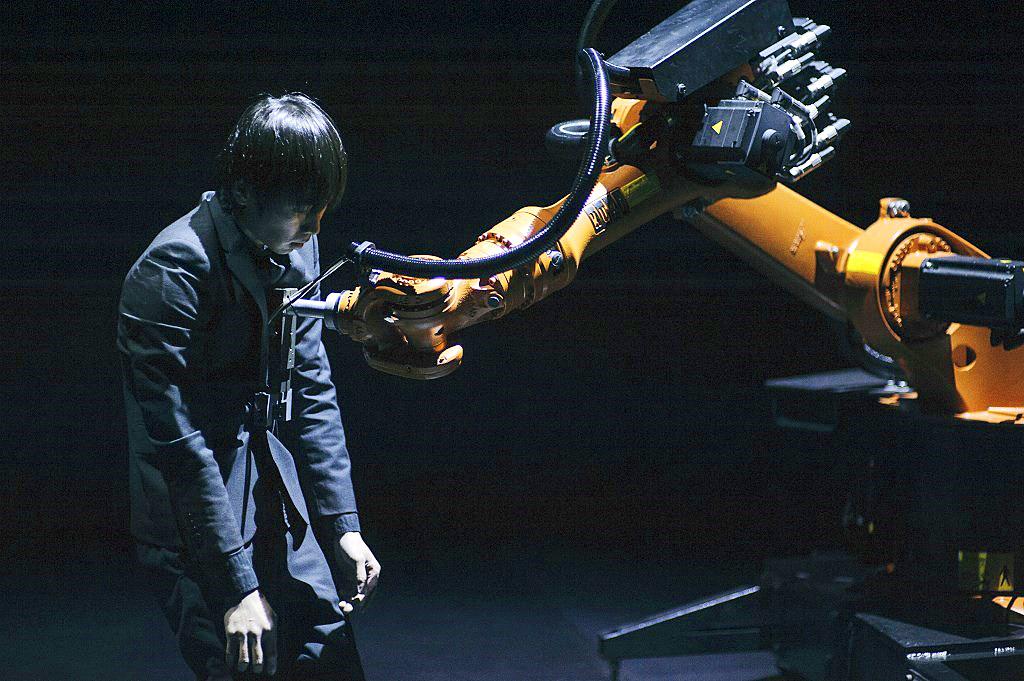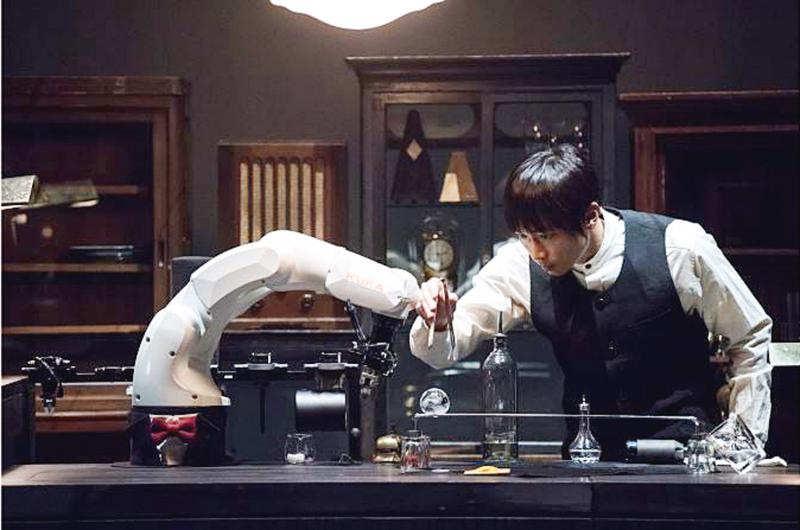After creating works involving robots for over a decade, choreographer Huang Yi (黃翊) is set to present his latest work in the spring in the form of a coffee shop set in the future.
In the upcoming production Little Ant & Robot: A Nomad Cafe, Huang further develops his dream of having robots and dancers perform together and interact with the audience, the choreographer said.
“The coffee shop is set in the future. I have been wondering about the possible interactions between people, as well as people and robots ever since I was little,” he said. “It should not be about technology replacing people in more and more areas,” said Huang, who envisages a harmonious relationship between people and robots, in which they help and support each other.

Photo: CNA
Huang, who is also a coder, first contacted German automation solution provider KUKA Robotics in 2010 and created Huang Yi & KUKA in 2012, in which he danced with a pre-programmed robotic arm that was over two meters in length.
The 2012 production has since been performed 78 times in 32 cities and 17 countries.
For his new production, which is scheduled to premiere at the National Theater in Taipei on April 23 before touring Taiwan through July, Huang uses a smaller 50-centimeter tall KUKA model.

Photo: CNA
KUKA will be programmed to serve coffee and dessert, interact with dancers, and use a drumstick to play rhythm, with some performances designed for families and children, said Huang.
Despite the fact that he is not a coffee drinker, his new work is set in a cafe and revolves around the drink — an important element in the lives of people he collaborates with — focusing on incorporating daily life into a dance piece, Huang said.
“It will be as if people can download fond memories here. There will be moments of people meeting with each other, parting, celebrating, as well as times of happiness, which are ‘saved’ in this work and can be played again and again like memories,” he said.
Apart from KUKA’s more detailed and intricate movements, Huang also mentioned the progress he is making with the new production.
“I’m very pleased that this time it is not just me writing the program,” he said, noting how every member of the production is more involved in the creative process.
For instance, one of the dancers is in charge of all technical aspects of the production, as well as designing the robot’s automation.
Huang also thanked Cloud Gate Dance Theatre founder Lin Hwai-min (林懷民) for his support, giving him lots of space and asking questions that helped clarify his ideas and taught him to be practical.
Given Lin is about 35 years his senior, Huang, who is in his late 30s, is also thinking about the role he can play for future artists, who he said are perhaps still babies now.
Huang believes 35 years is just about the time needed for an artist to make a major breakthrough in both the arts and technology.
“Then I can offer more substantial assistance,” he said, “the person [who would have my assistance] could be Taiwanese or a foreigner. I’ll wait for the individual to come to see a performance and to grow up.”
“I’ll encourage that person to have a unique voice, to contribute to the industry and to create art for his/her generation,” he said.
Little Ant & Robot: A Nomad Cafe will be staged at the National Theater April 23 to April 25, before moving to Songshan Cultural and Creative Park in Taipei for a month-long presentation in a more intimate setting in May.
The production will then move to the National Taichung Theater June 4 to June 6 and the National Kaohsiung Center for the Arts July 10 to July 11.

Exceptions to the rule are sometimes revealing. For a brief few years, there was an emerging ideological split between the Democratic Progressive Party (DPP) and Chinese Nationalist Party (KMT) that appeared to be pushing the DPP in a direction that would be considered more liberal, and the KMT more conservative. In the previous column, “The KMT-DPP’s bureaucrat-led developmental state” (Dec. 11, page 12), we examined how Taiwan’s democratic system developed, and how both the two main parties largely accepted a similar consensus on how Taiwan should be run domestically and did not split along the left-right lines more familiar in

This month the government ordered a one-year block of Xiaohongshu (小紅書) or Rednote, a Chinese social media platform with more than 3 million users in Taiwan. The government pointed to widespread fraud activity on the platform, along with cybersecurity failures. Officials said that they had reached out to the company and asked it to change. However, they received no response. The pro-China parties, the Chinese Nationalist Party (KMT) and Taiwan People’s Party (TPP), immediately swung into action, denouncing the ban as an attack on free speech. This “free speech” claim was then echoed by the People’s Republic of China (PRC),

As I finally slid into the warm embrace of the hot, clifftop pool, it was a serene moment of reflection. The sound of the river reflected off the cave walls, the white of our camping lights reflected off the dark, shimmering surface of the water, and I reflected on how fortunate I was to be here. After all, the beautiful walk through narrow canyons that had brought us here had been inaccessible for five years — and will be again soon. The day had started at the Huisun Forest Area (惠蓀林場), at the end of Nantou County Route 80, north and east

Specialty sandwiches loaded with the contents of an entire charcuterie board, overflowing with sauces, creams and all manner of creative add-ons, is perhaps one of the biggest global food trends of this year. From London to New York, lines form down the block for mortadella, burrata, pistachio and more stuffed between slices of fresh sourdough, rye or focaccia. To try the trend in Taipei, Munchies Mafia is for sure the spot — could this be the best sandwich in town? Carlos from Spain and Sergio from Mexico opened this spot just seven months ago. The two met working in the